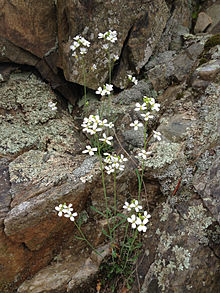Arabidopsis lyrata

Arabidopsis lyrata is a species of flowering plant in the family Brassicaceae, closely related to the model organism Arabidopsis thaliana.
Arabidopsis lyrata are diploid plants that have a life span of two or more years, small white flowers and highly distinct basal leaves with a height of 10–40 centimetres (4–16 in).[1] The stem leaves are arranged alternately, with linear and slightly curved margins that are smooth and having a base that is tapered.[1] The leaves of Arabidopsis lyrata have glucosinolates and trichomes as defense mechanisms against insect herbivores, and any other potential threats, such as fires and human activity.[1]
“The flowers on this species are quite tiny, ranging from 3–8 mm in size, they are pure white with four lobes, and are borne on wide rising pedicels, that range from 7 to 12 mm in length.”[1] These plants are insect pollinated and tend to bloom between the months of May right through June and produces fruits in early August.[1] The fruit of Arabidopsis lyrata are about 2–4.5 millimetres (0.08–0.18 in) in length, elongated, and papery, while the seeds are 1 mm (0.04 in) long, and are arranged in a row .[1]
Habitat and range
Arabidopsis lyrata is found largely in subarctic or subalpine environments with thin soils, such as rock faces, eskers and talus slopes, or exposed coastal zones.[1] Individual plants may form solitary rosettes, and are able to reproduce asexually through clonal patches.[1] Lastly, Arabidopsis does not survive in agro-ecosystems in which weeds are rampant; it performs best under low competition and therefore has a life cycle that depends on germination, growth, and the setting of seeds in a very short amount of time before other species of plants can prevent light access.[2]
Arabidopsis lyrata has a circumpolar distribution, meaning it is found across northern and central Europe, Asia, and North America.[3] In the US state of Virginia, it can be found growing in rocky woodlands, barrens, and crevices or thin-soiled ledges on outcrops of limestone, dolomite, siltstone, metasiltstone, amphibolite, metabasalt, diabase, and other mafic and felsic igneous and metamorphic rocks.[4] It is also located in areas of the eastern United States where it is usually limited to sand bars.[5] In Europe it has been found in southern Germany and restricted areas of Sweden.[5]
